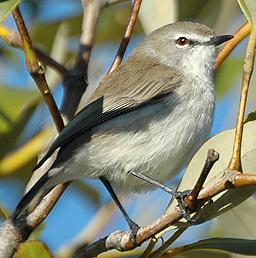Mangrove gerygone facts for kids
Quick facts for kids Mangrove gerygone |
|
|---|---|
 |
|
| Conservation status | |
| Scientific classification | |
| Genus: |
Gerygone
|
| Species: |
levigaster
|
| Subspecies | |
|
|
The mangrove gerygone (Gerygone levigaster) is a small bird from the Australian warbler Acanthizidae family. It is also known as the mangrove warbler. This bird is closely related to other gerygone species, like the fan-tailed gerygone and the western gerygone.
There are three different types, or subspecies, of the mangrove gerygone. G. l. pallida lives in southern New Guinea. G. l. levigaster is found along the coast from Western Australia to northern Queensland. The third type, G. l. cantator, lives along the coast from Queensland down to New South Wales.
Even though some mangrove forests where these birds live have been cleared, the mangrove gerygone is not considered an endangered species by the IUCN.
Contents
Where do Mangrove Gerygones Live?
The mangrove gerygone mainly lives in mangrove forests. These are special forests that grow in salty water along coastlines. They also live in other forests and woodlands right next to mangroves.
These birds often fly into nearby forests to find food, especially when they are raising their young. In some areas, like the Kimberley region, the mangrove gerygone might be found in scrubland with paperbark and acacia trees instead of mangroves. This happens when its home overlaps with another bird, the large-billed gerygone, which prefers the mangroves there.
What Does a Mangrove Gerygone Look Like?
The mangrove gerygone is a typical bird of its kind. It is small, only about 9 to 11 centimeters (3.5 to 4.3 inches) long. It weighs around 6 grams, which is about as much as a few paper clips!
These birds have rounded wings. Their feathers are grey on top, with a white throat, belly, sides, and rump. They have a clear white stripe above their eye. Their bill and legs are black, and their eyes are red.
- G. l. pallida is a little browner on its back.
- G. l. cantator is slightly bigger and heavier than the other types.
The song of the mangrove gerygone is very pretty. People describe it as "sweet, rich, and tuneful." It sounds similar to the song of the western gerygone.
What do Mangrove Gerygones Eat?
Mangrove gerygones eat insects. They find their food among the leaves of trees. Their diet includes beetles, grasshoppers, wasps, ants, and moths.
Unlike some other gerygone birds, they do not often catch insects while flying. They sometimes join mixed-species feeding flocks with other birds like white-eyes, honey-eaters, and fantails. While they mostly look for food in the treetops, they will also search for insects among the roots of mangrove trees.
Mangrove Gerygone Life Cycle and Reproduction
Mangrove gerygones can breed throughout the year. However, they mostly breed in spring and summer in eastern Australia. In the northern parts of Australia, they usually breed during the dry season.
The female bird builds an oval-shaped, domed nest. She uses roots, grass, spider webs, moss, seaweed, and bark to build it. The nest hangs down from mangrove trees.
The female lays two to three eggs in the nest. She then sits on the eggs for 14 to 17 days to keep them warm until they hatch. Once the chicks hatch, both parents work together to feed them for another 14 to 17 days.
Some cuckoo species are known as brood parasites of the mangrove gerygone. This means that cuckoos lay their eggs in the gerygone's nest, and the gerygone parents end up raising the cuckoo chicks.
Images for kids
See also
 In Spanish: Gerygone levigaster para niños
In Spanish: Gerygone levigaster para niños



